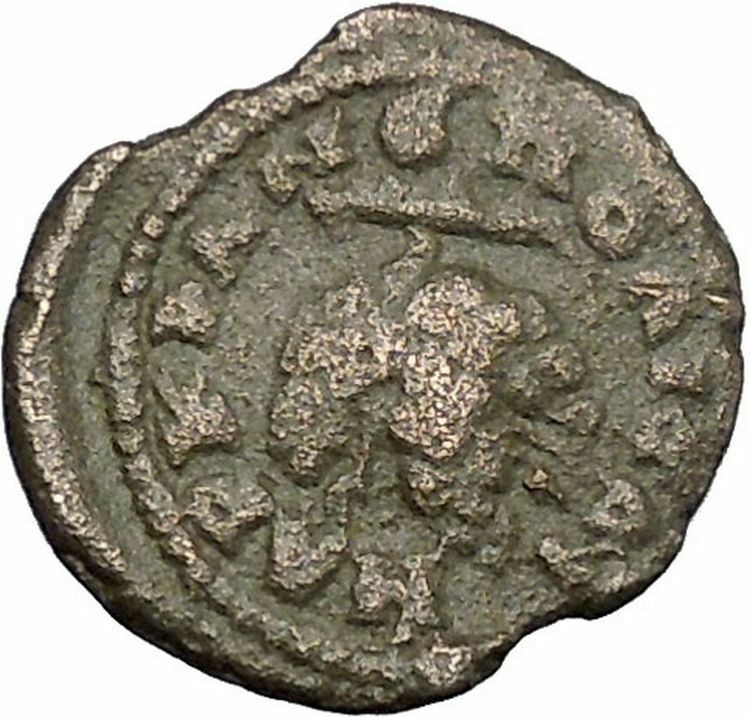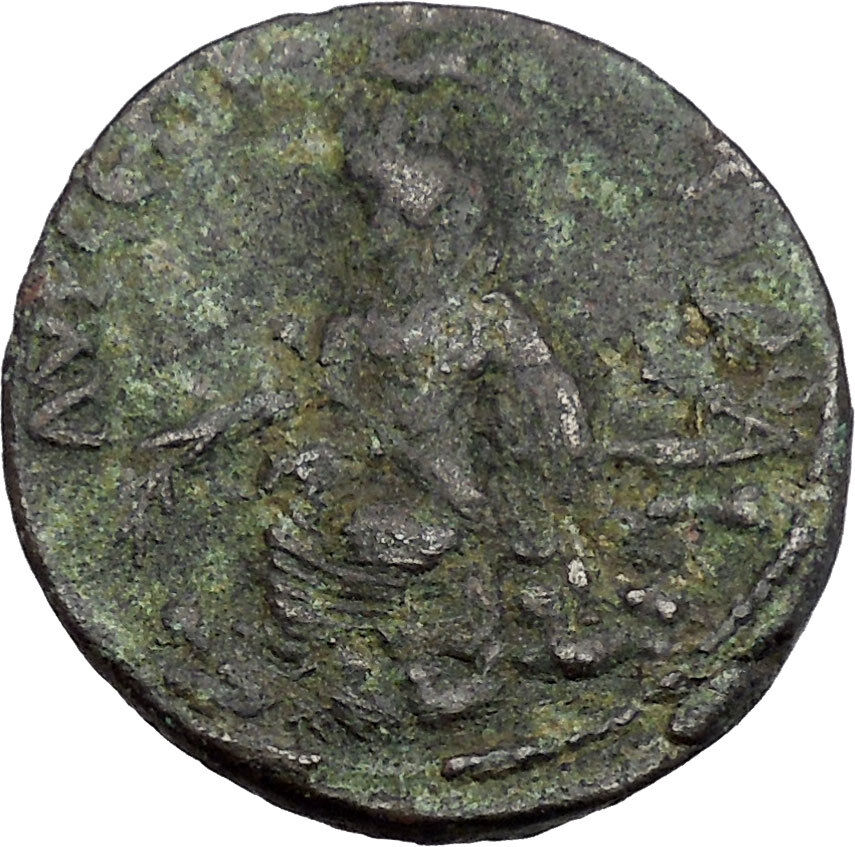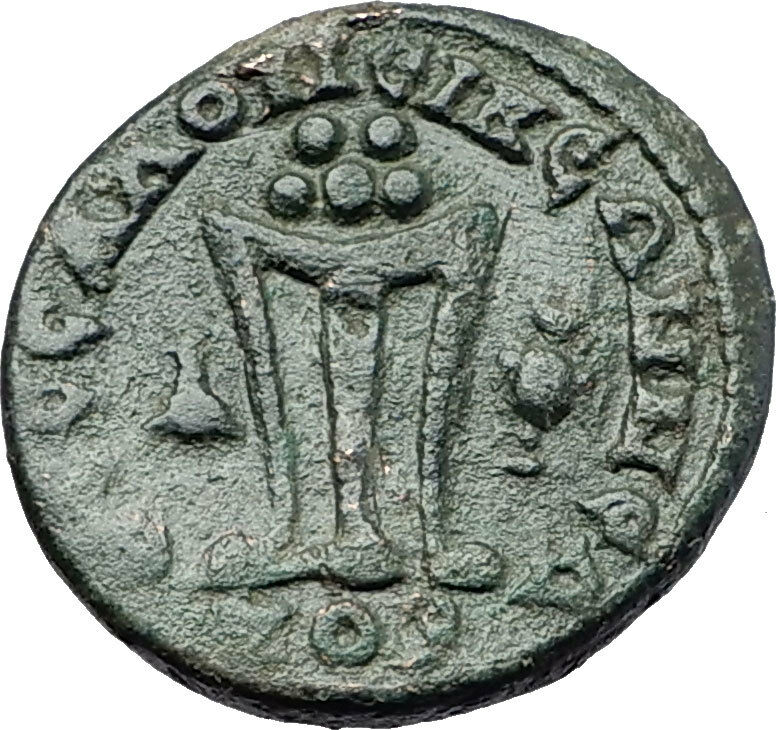|
Gordian III – Roman Emperor: 238-244 A.D. –
Bronze 20mm (3.21 grams) from the Roman provincial city of Nicaea in the
province of Bythinia
Reference: SNGCop 526, BMC 114, SGI 3671. –
M ANT ΓOPΔIANOC AV, radiate, draped bust right.
NIKAEΩN, Four legionary standards, two inner ones topped with Capricorns,
outer
two topped with wreaths.
You are bidding on the exact
item pictured, provided with a Certificate of Authenticity and Lifetime
Guarantee of Authenticity.
Early history, Roman and Byzantine Empires
The place is said to have been colonized by
Bottiaeans
,
and to have originally borne the name of Ancore (Steph.
B. s. v.) or Helicore (Geogr. Min. p. 40, ed. Hudson); but it was
subsequently destroyed by the
Mysians
. A
few years after the death of
Alexander the Great
,
Macedonian
king
Antigonus
— who had taken control of much of
Asia Minor
upon the death of Alexander (under whom Antigonus had served as a
general) — probably after his victory over
Eumenes
, in
316 BC, rebuilt the town, and called it, after himself, Antigoneia (Greek:
Αντιγόνεια). (Steph. B. l. c.; Eustath. ad
Horn. II. ii. 863) Several other of Alexander’s generals (known together as the
Diadochi
(Latin; original Greek
DiadokhoiΔιάδοχοι/
“successors”)) later conspired to remove Antigonus, and after defeating him the
area was given to
Thessalian
general Lysimachus
(Lysimakhos) (circa 355 BC-281 BC) in 301 BC as his share
of the lands. He renamed it Nicaea (Greek:
Νίκαια
, also
transliterated
as Nikaia or Nicæa; see also
List of traditional Greek place names
), in tribute to his wife Nicaea, a
daughter of Antipater
. (Steph. B., Eustath., Strab., ll. cc.) According to another
account (Memnon, ap. Phot. Cod. 224. p. 233, ed. Bekker), Nicaea was founded by
men from
Nicaea
near
Thermopylae
, who had served in the army of Alexander the Great. The town was
built with great regularity, in the form of a square, measuring 16 stadia in
circumference; it had four gates, and all its streets intersected one another at
right angles, so that from a monument in the centre all the four gates could be
seen. (Strabo
xii. pp. 565 et seq.) This monument stood in the gymnasium, which was
destroyed by fire, but was restored with increased magnificence by the
younger Pliny
(Epist. x. 48), when he was governor of
Bithynia
.
The city was built on an important crossroads between
Galatia
and
Phrygia
, and
thus saw steady trade. Soon after the time of Lysimachus, Nicaea became a city
of great importance, and the kings of Bithynia, whose era begins in 288 BC with
Zipoetes
, often resided at Nicaea. It has already been mentioned that in the
time of Strabo it is called the metropolis of Bithynia, an honour which is also
assigned to it on some coins, though in later times it was enjoyed by
Nicomedia
.
The two cities, in fact, kept up a long and vehement dispute about the
precedence, and the 38th oration of
Dio
Chrysostomus
was expressly composed to settle the dispute. From this
oration, it appears that Nicomedia alone had a right to the title of metropolis,
but both were the first cities of the country.
The younger Pliny makes frequent mention of Nicaea and its public buildings,
which he undertook to restore when governor of Bithynia. (Epist. x. 40, 48,
etc.) It was the birthplace of the astronomer
Hipparchus
(ca. 194 BC), the mathematician and astronomer
Sporus
(ca. 240) and the historian
Dio Cassius
(ca. 165).[1]
It was the death-place of the comedian
Philistion
. The numerous coins of Nicaea which still exist attest the
interest taken in the city by the emperors, as well as its attachment to the
rulers; many of them commemorate great festivals celebrated there in honour of
gods and emperors, as Olympia, Isthmia, Dionysia, Pythia, Commodia, Severia,
Philadelphia, etc. Throughout the imperial period, Nicaea remained an important
town; for its situation was particularly favourable, being only 40 km (25 mi)
distant from Prusa
(Pliny
v. 32), and 70 km (43 mi) from
Constantinople
. (It.
Ant. p. 141.) When Constantinople became the capital of the
Eastern Empire
, Nicaea did not lose in importance; for its present walls,
which were erected during the last period of the Empire, enclose a much greater
space than that ascribed to the place in the time of Strabo. Much of the
existing architecture and defensive works date to this time, early 300s.
Nicaea suffered much from earthquakes in 358, 362 and 368; after the last of
which, it was restored by the emperor
Valens
. During
the Middle Ages it was for a long time a strong bulwark of the
Byzantine
emperors against the
Turks
.
Nicaea
in early Christianity
See also:
First Council of Nicaea
and
Second Council of Nicaea
In the reign of
Constantine
, 325, the celebrated
First Council of Nicaea
was held there against the
Arian
heresy
, and the
prelates there defined more clearly the concept of the
Trinity
and
drew up the
Nicene
Creed
. The doctrine
of the Trinity was finalized at the Council of Constantinople in
381 AD which expressly included the Holy Ghost as equal to the Father and the
Son. The first Nicene Council was probably held in what would become the now
ruined mosque of Orchan. The church of Hagia Sophia was built by
Justinian
I
in the middle of the city in the 6th century (modelled after the larger
Hagia
Sophia
in Constantinople), and it was there that the
Second Council of Nicaea
met in 787 to discuss the issues of
iconography
.
Marcus Antonius Gordianus Pius (January
20, 225
–
February
11
, 244
),
known in
English
as Gordian III,
 was was
Roman
Emperor
from 238 to 244. Gordian was the son of
Antonia Gordiana
and his father was an unnamed Roman Senator who died before
238. Antonia Gordiana was the daughter of Emperor
Gordian I
and younger sister of Emperor
Gordian II
.
Very little is known on his early life before becoming Roman Emperor. Gordian
had assumed the name of his maternal grandfather in 238.
Rise to power
Following the murder of emperor
Alexander Severus
in Moguntiacum (modern
Mainz
), the
capital of the
Roman province
Germania Inferior
,
Maximinus Thrax
was acclaimed emperor, despite strong opposition of the
Roman senate
and the majority of the population. In response to what was
considered in Rome as a rebellion, Gordian’s grandfather and uncle, Gordian I
and II, were proclaimed joint emperors in the
Africa Province
. Their revolt was suppressed within a month by Cappellianus,
governor of Numidia
and a loyal supporter of Maximinus Thrax. The elder Gordians died,
but public opinion cherished their memory as peace loving and literate men,
victims of Maximinus’ oppression.
Meanwhile, Maximinus was on the verge of marching on Rome and
the Senate elected
Pupienus
and Balbinus
as joint emperors. These senators were not popular men and the population of
Rome was still shocked by the elder Gordian’s fate, so that the Senate decided
to take the teenager Gordian, rename him Marcus Antonius Gordianus as his
grandfather, and raise him to the rank of
Caesar
and imperial heir.
Pupienus
and Balbinus
defeated Maximinus, mainly due to the defection of several
legions
,
namely the
Parthica II
who assassinated Maximinus. But their joint reign was
doomed from the start with popular riots, military discontent and even an
enormous fire that consumed Rome in June 238. On
July 29
,
Pupienus and Balbinus were killed by the
Praetorian guard
and Gordian proclaimed sole emperor.
Rule
Due to Gordian’s age, the imperial government was surrendered
to the aristocratic families, who controlled the affairs of Rome through the
senate. In 240,
Sabinianus
revolted in the African province, but the situation was dealt quickly. In 241,
Gordian was married to Furia Sabinia
Tranquillina
, daughter of the newly appointed praetorian prefect,
Timesitheus
. As chief of the Praetorian guard and father in law of the
emperor, Timesitheus quickly became the de facto ruler of the Roman
empire.
In the 3rd century, the Roman frontiers weakened against the
Germanic tribes across the
Rhine
and
Danube
, and the
Sassanid
kingdom across the
Euphrates
increased its own attacks. When the Persians under
Shapur I
invaded Mesopotamia
, the young emperor opened the doors of the
Temple of Janus
for the last time in Roman history, and sent a huge army to
the East. The Sassanids were driven back over the Euphrates and defeated in the
Battle of Resaena
(243). The campaign was a success and Gordian, who had
joined the army, was planning an invasion of the enemy’s territory, when his
father-in-law died in unclear circumstances. Without Timesitheus, the campaign,
and the emperor’s security, were at risk.
Marcus Julius Philippus, also known as
Philip the Arab
, stepped in at this moment as the new Praetorian Prefect and
the campaign proceeded. In the beginning of 244, the Persians counter-attacked.
Persian sources claim that a battle was fought (Battle
of Misiche) near modern
Fallujah
(Iraq)
and resulted in a major Roman defeat and the death of Gordian III[1].
Roman sources do not mention this battle and suggest that Gordian died far away,
upstream of the Euphrates. Although ancient sources often described Philip, who
succeeded Gordian as emperor, as having murdered Gordian at Zaitha (Qalat es
Salihiyah), the cause of Gordian’s death is unknown.
Gordian’s youth and good nature, along with the deaths of his
grandfather and uncle and his own tragic fate at the hands of another usurper,
granted him the everlasting esteem of the Romans. Despite the opposition of the
new emperor, Gordian was deified by the Senate after his death, in order to
appease the population and avoid riots.
|





 was
was


